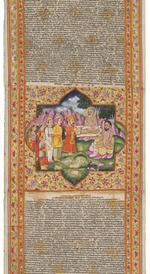A monumental epic (or perhaps more correctly a 'chronicle') dated as a text to about 400 BCE – 400 CE, the Mahābhārata consists of dramatic narrative and sermonising didactic on ethics and moral law (dharma) as played out in the lives of two groups of dynastic cousins who fought over control of Bhāratavarṣa, present day central north India. It is one of the two major epics of ancient India, the other being the Rāmāyaṇa. This extensive scroll, made by a workshop of scribes and painters, is inscribed with text in Sanskrit and punctuated by decorative cartouches inset with delicately rendered illustrations from the story.
Sequence of miniatures
The text is preceded by a series of 15 large miniatures, with others between the various parvans (books), as well as a series of small quatrefoil-shaped ones interspersed through the text of the Ᾱdiparvan and Sabhāparvan, as detailed below. There is no special treatment for the Bhagavadgītā. All the miniatures have gold backgrounds with red and white flowers, green leaves, blue diamond shapes and gold flowers in orange cartouches.
Click here to open a detailed description of the illustrations.

